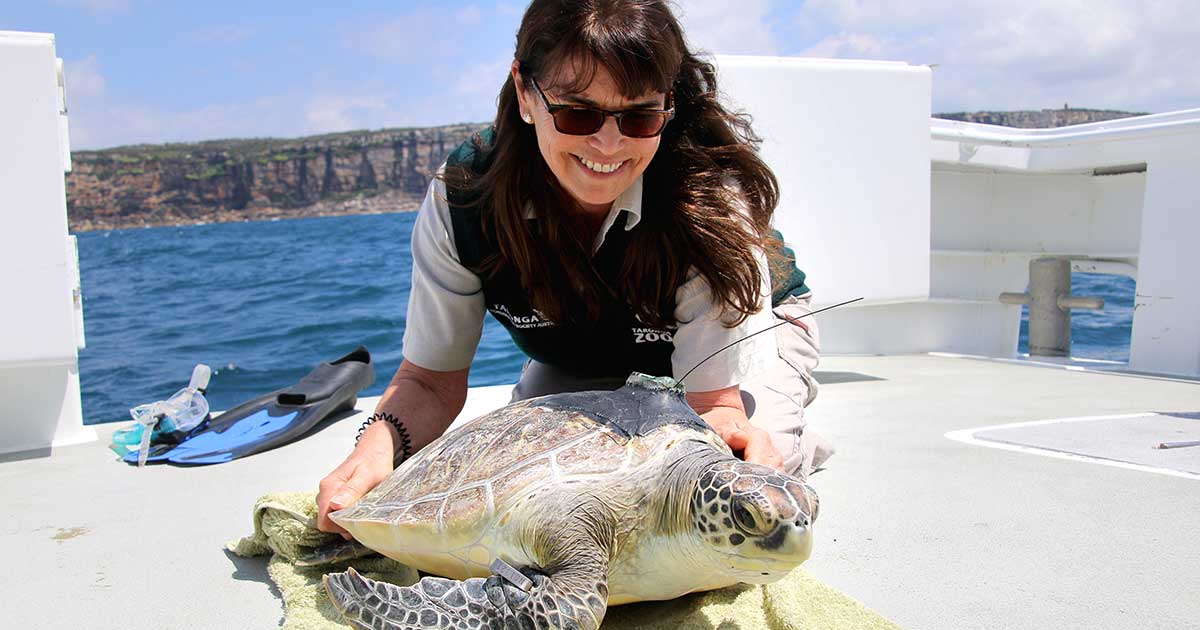Posted on 18th December 2017 by Media Relations
Every year at Taronga, numerous marine turtles are rescued and rehabilitated at our wildlife hospital. More often than not, these living dinosaurs have ingested some form of plastic.
Taronga Zoo’s wildlife hospital manager, Libby Hall, once treated a sea turtle with four different colours of balloon inside its stomach. Unfortunately, this story isn’t a unique one. Many marine species are impacted by single-use plastic, particularly balloons.

What goes up must come down
When helium balloons float into the air, they eventually pop, entering the litter stream and posing a direct threat to wildlife on land and in the ocean. Helium balloons can travel great distances, bursting kilometres away from where they were originally released.
Dolphins, whales, turtles, and many other marine species, as well as terrestrial animals such as cows, dogs, sheep, tortoises, birds and other animals can be injured or killed by ingesting balloons, after mistaking them for food.
If the balloon blocks the digestive tract, animals like marine turtles are unable to take in any more nutrients. Wildlife can also become entangled in the balloon string, rendering them unable to move or eat.
Even if balloons aren’t filled with helium, they can still pose a threat to wildlife if they end up in our environment and are ingested. Like disposable plastic bags, water bottles and straws they’re a single-use item we just don’t need – and neither do our oceans.
What about ‘biodegradable’ latex?
Balloons labelled as latex are not a great alternative to the regular kind of balloon. Biodegradable latex doesn't degrade for at least a few years, and in that time can cause just as much harm as regular balloons.
Some retailers claim that latex balloons biodegrade at the same rate as an oak leaf does. These leaves are durable, and can take more than four years to break down! In four years a discarded balloon can cause plenty of damage to wildlife.
When these balloons burst, they look just like jellyfish – which is a sea turtles favourite snack. To a sea turtle, brightly coloured pieces of plastic like balloons bear a striking resemblance to jellyfish or sponges and are regularly ingested, often with fatal results. It can take just a single fragment of a balloon to end the life of a sea turtle, and with all species endangered or critically endangered we need to be doing everything we can to conserve populations.
What to use instead
With a little bit of creativity, there are plenty of ways balloons can be replaced at your next event!
Environmentally friendly alternatives include material flags, banners, streamers or bunting, which can be branded and re-used for events in the future. If you were planning on commemorating an event with a balloon release, you could blow bubbles or plant a tree instead. There are some great alternatives here.
Let attendees of your next event know why you’ve decided against decorating or releasing balloons, so they too can be aware of the issue and make the same decision in the future. Zoos Victoria has some fantastic resources to let event guests know that you’re a balloon free zone.
Decorating your birthday party or releasing balloons to commemorate an event seems like a fun idea, but when you consider the environmental impacts it’s just not worth it. Choose an alternative option instead and celebrate in a way that’s for the wild.
At Taronga, we believe that wildlife and people can share this planet. But right now, wildlife globally is under threat and they need your help more than ever. Find out more about how you can take action for our oceans.